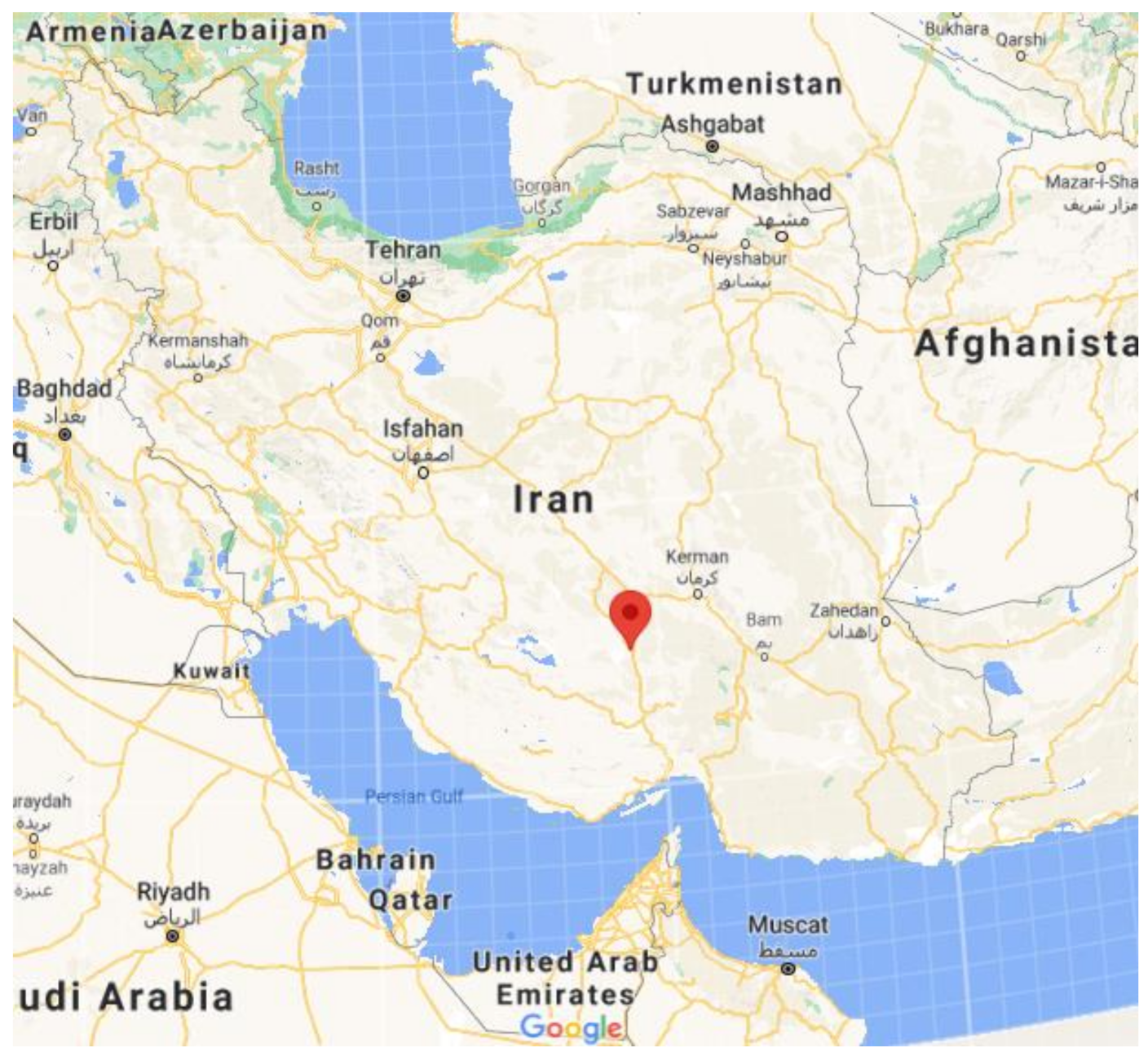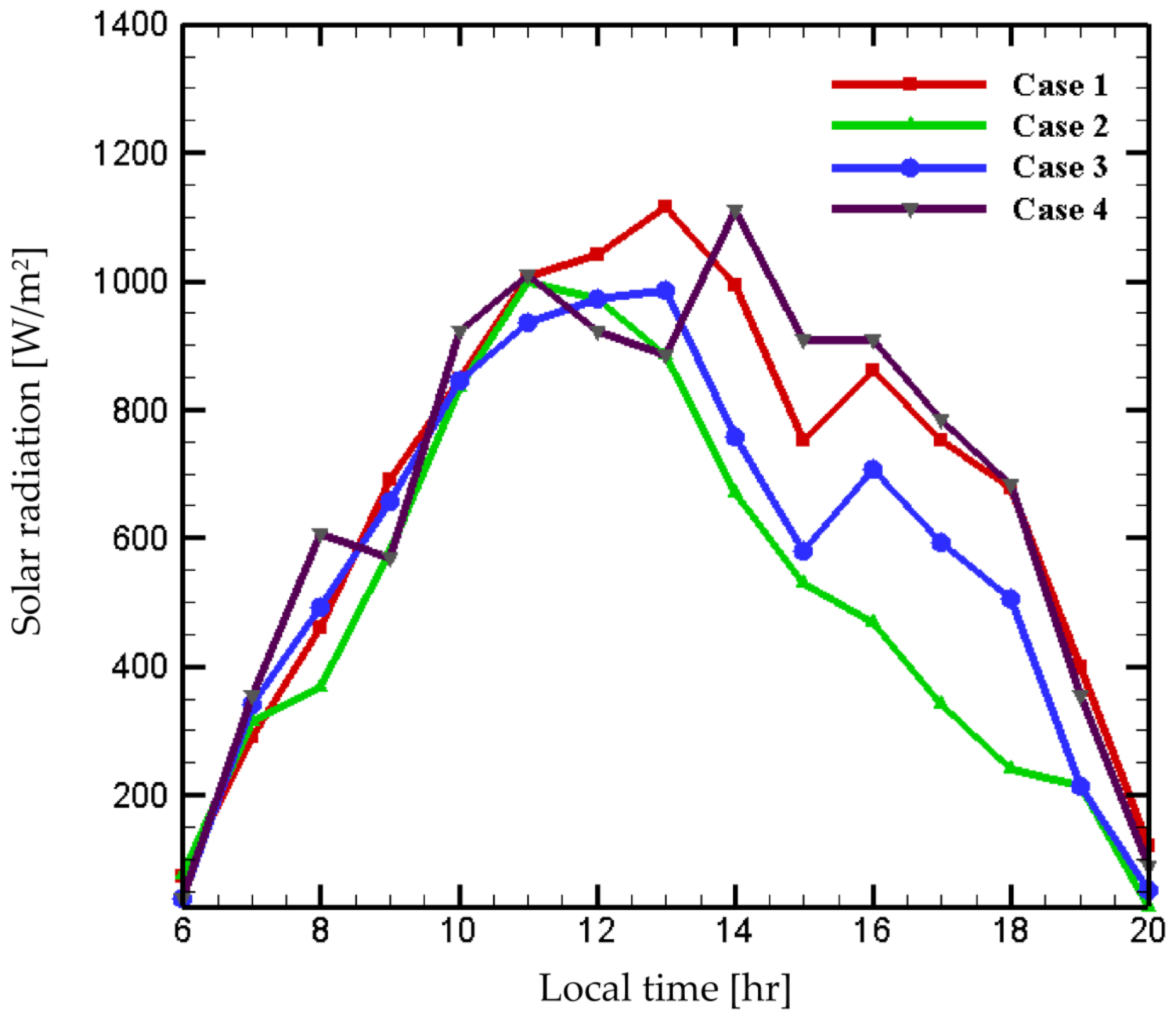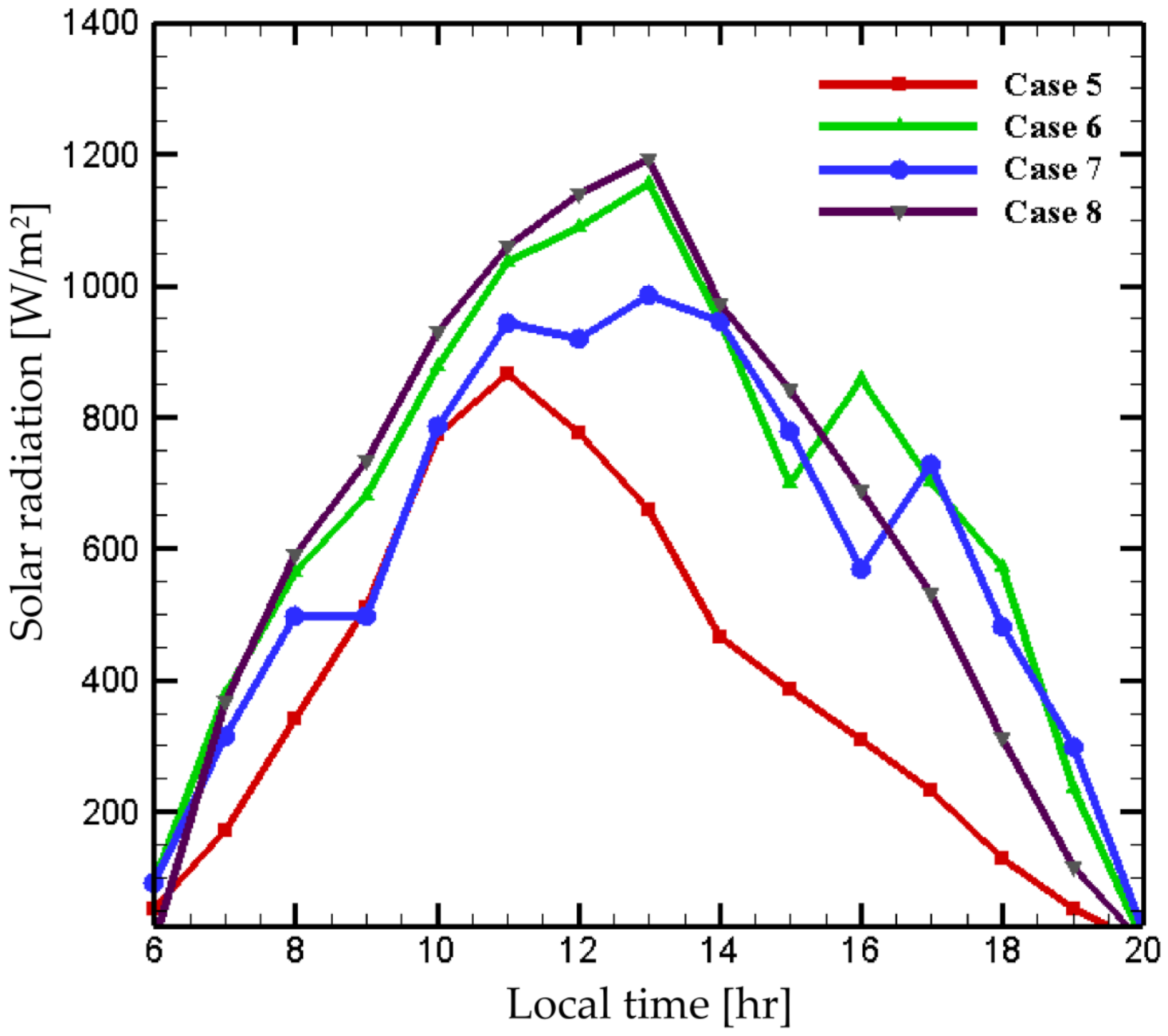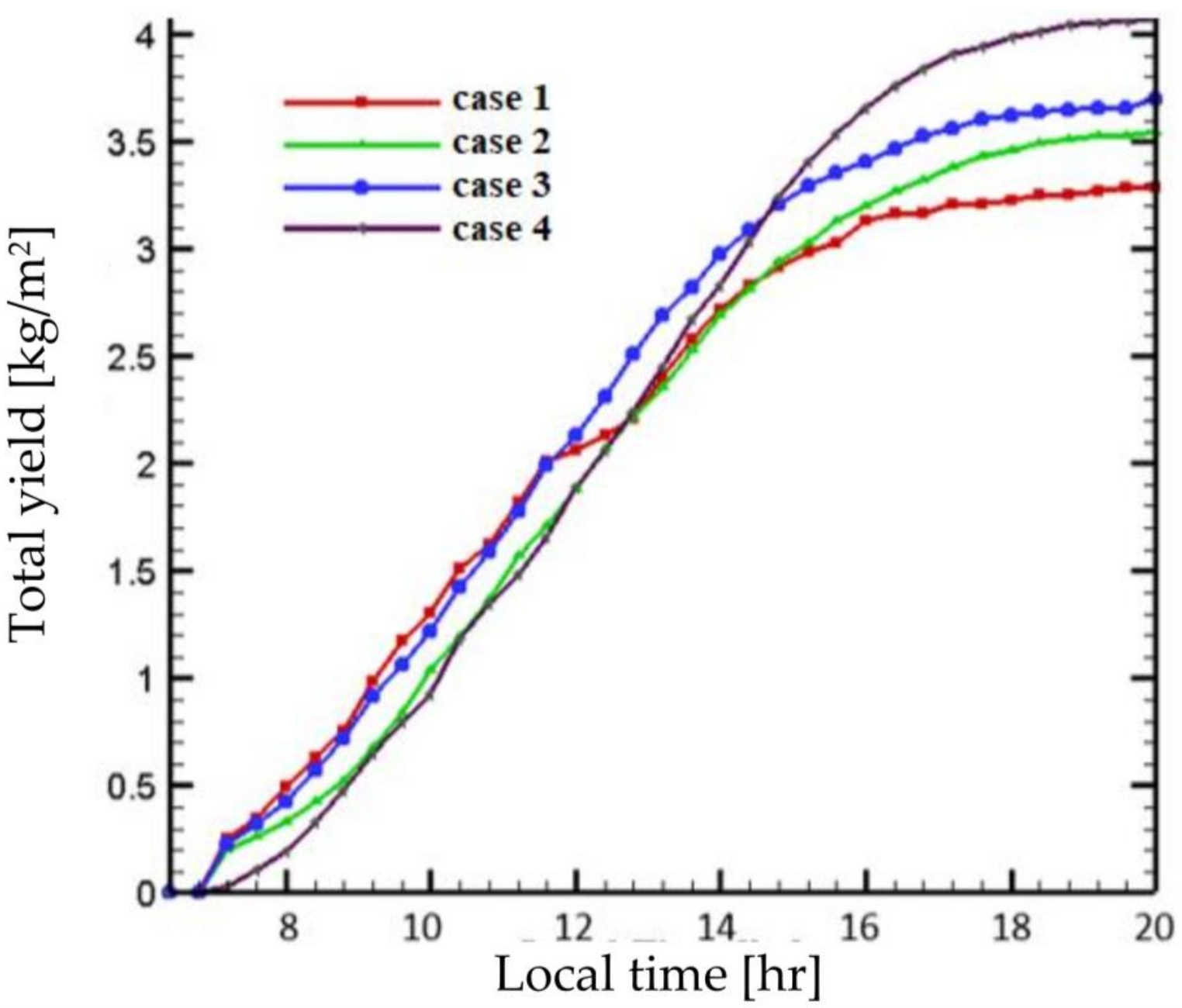Techno-Economic Study of a New Hybrid Solar Desalination System for Producing Fresh Water in a Hot–Arid Climate
Abstract
:1. Introduction
2. Case Study
3. Experimental Setup
4. Results
5. Conclusions
Author Contributions
Funding
Institutional Review Board Statement
Informed Consent Statement
Data Availability Statement
Conflicts of Interest
References
- Görgülü, A.; Yağlı, H.; Koç, Y.; Koç, A. Comprehensive analysis of the effect of water injection on performance and emission parameters of the hydrogen fuelled recuperative and non-recuperative gas turbine system. Int. J. Hydrog. Energy 2020, 45, 34254–34267. [Google Scholar] [CrossRef]
- Safaei, M.R.; Tlili, I.; Gholamalizadeh, E.; Abbas, T.; Alkanhal, T.A.; Goodarzi, M.; Dahari, M. Thermal analysis of a binary base fluid in pool boiling system of glycol–water alumina nano-suspension. J. Therm. Anal. Calorim. 2021, 143, 2453–2462. [Google Scholar] [CrossRef]
- Ustun, I.; Karakus, C.; Yagli, H. Empirical models for estimating the daily and monthly global solar radiation for Mediterranean and Central Anatolia region of Turkey. Int. J. Glob. Warm. 2020, 20, 249–275. [Google Scholar] [CrossRef]
- Sadeghzadeh, M.; Ghorbani, B.; Ahmadi, M.H.; Sharma, S. A solar-driven plant to produce power, cooling, freshwater, and hot water for an industrial complex. Energy Rep. 2021, 7, 5344–5358. [Google Scholar] [CrossRef]
- Safaei, M.R.; Goshayeshi, H.R.; Chaer, I. Solar still efficiency enhancement by using graphene oxide/paraffin nano-PCM. Energies 2019, 12, 2002. [Google Scholar] [CrossRef] [Green Version]
- Yağli, H. Examining the receiver heat loss, parametric optimization and exergy analysis of a solar power tower (SPT) system. Energy Sources Part A Recovery Util. Environ. Eff. 2020, 42, 2155–2180. [Google Scholar] [CrossRef]
- Pourkiaei, S.M.; Ahmadi, M.H.; Ghazvini, M.; Moosavi, S.; Pourfayaz, F.; Kumar, R.; Chen, L. Status of direct and indirect solar desalination methods: Comprehensive review. Eur. Phys. J. Plus 2021, 136, 1–36. [Google Scholar] [CrossRef]
- Makki, M.; Izadi, A.I.; Jalili, B. Numerical analysis of a multi-stage evacuation desalination in Tehran city. Water Energy Int. 2019, 61, 53–57. [Google Scholar]
- Parsa, S.M.; Javadi, D.; Rahbar, A.; Majidniya, M.; Aberoumand, S.; Amidpour, Y.; Amidpour, M. Experimental assessment on passive solar distillation system on Mount Tochal at the height of 3964 m: Study at high altitude. Desalination 2019, 466, 77–88. [Google Scholar] [CrossRef]
- Goshayeshi, H.R.; Safaei, M.R. Effect of absorber plate surface shape and glass cover inclination angle on the performance of a passive solar still. Int. J. Numer. Methods Heat Fluid Flow 2019, 30, 3183–3198. [Google Scholar] [CrossRef]
- Sohani, A.; Hoseinzadeh, S.; Berenjkar, K. Experimental analysis of innovative designs for solar still desalination technologies; an in-depth technical and economic assessment. J. Energy Storage 2021, 33, 101862. [Google Scholar] [CrossRef]
- Hedayati-Mehdiabadi, E.; Sarhaddi, F.; Sobhnamayan, F. Exergy performance evaluation of a basin-type double-slope solar still equipped with phase-change material and PV/T collector. Renew. Energy 2020, 145, 2409–2425. [Google Scholar] [CrossRef]
- Manokar, A.M.; Taamneh, Y.; Winston, D.P.; Vijayabalan, P.; Balaji, D.; Sathyamurthy, R.; Sundar, S.P.; Mageshbabu, D. Effect of water depth and insulation on the productivity of an acrylic pyramid solar still–An experimental study. Groundw. Sustain. Dev. 2020, 10, 100319. [Google Scholar] [CrossRef]
- Parsa, S.M.; Javadi, D.; Rahbar, A.; Majidniya, M.; Salimi, M.; Amidpour, Y.; Amidpour, M. Experimental investigation at a summit above 13,000 ft on active solar still water purification powered by photovoltaic: A comparative study. Desalination 2020, 476, 114146. [Google Scholar] [CrossRef]
- Thakkar, H.; Sadasivuni, K.k.; Ramana, P.V.; Panchal, H.; Suresh, M.; Israr, M.; Elklawy, M.; AlmElDin, H. Comparative analysis of the use of flash evaporator and solar still with a solar desalination system. Int. J. Ambient Energy 2020, 1–8. [Google Scholar] [CrossRef]
- Hassan, H. Comparing the performance of passive and active double and single slope solar stills incorporated with parabolic trough collector via energy, exergy and productivity. Renew. Energy 2020, 148, 437–450. [Google Scholar] [CrossRef]
- Manokar, A.M.; Winston, D.P.; Sathyamurthy, R.; Kabeel, A.E.; Prasath, A.R. Experimental investigation on pyramid solar still in passive and active mode. Heat Mass Transf. 2019, 55, 1045–1058. [Google Scholar] [CrossRef]
- Panchal, H.; Taamneh, Y.; Sathyamurthy, R.; Kabeel, A.E.; El-Agouz, S.A.; Naveen Kumar, P.; Manokar, A.M.; Arunkumar, T.; Mageshbabu, D.; Bharathwaaj, R. Economic and exergy investigation of triangular pyramid solar still integrated to inclined solar still with baffles. Int. J. Ambient Energy 2019, 40, 571–576. [Google Scholar] [CrossRef]
- Omara, Z.M.; Kabeel, A.E.; Abdullah, A.S.; Essa, F.A. Experimental investigation of corrugated absorber solar still with wick and reflectors. Desalination 2016, 381, 111–116. [Google Scholar] [CrossRef]
- Omara, Z.M.; Kabeel, A.E.; Younes, M.M. Enhancing the stepped solar still performance using internal reflectors. Desalination 2013, 314, 67–72. [Google Scholar] [CrossRef]
- Srivastava, P.K.; Agrawal, S.K. Winter and summer performance of single sloped basin type solar still integrated with extended porous fins. Desalination 2013, 319, 73–78. [Google Scholar] [CrossRef]
- Feilizadeh, M.; Estahbanati, M.R.K.; Khorram, M.; Rahimpour, M.R. Experimental investigation of an active thermosyphon solar still with enhanced condenser. Renew. Energy 2019, 143, 328–334. [Google Scholar] [CrossRef]
- Manokar, A.M.; Winston, D.P.; Kabeel, A.E.; Sathyamurthy, R. Sustainable fresh water and power production by integrating PV panel in inclined solar still. J. Clean. Prod. 2018, 172, 2711–2719. [Google Scholar] [CrossRef]
- Rashidi, S.; Rahbar, N.; Valipour, M.S.; Esfahani, J.A. Enhancement of solar still by reticular porous media: Experimental investigation with exergy and economic analysis. Appl. Therm. Eng. 2018, 130, 1341–1348. [Google Scholar] [CrossRef]
- Panchal, H.; Mevada, D.; Sathyamurthy, R. The requirement of various methods to improve distillate output of solar still: A review. Int. J. Ambient Energy 2021, 42, 597–603. [Google Scholar] [CrossRef]
- Sohani, A.; Hoseinzadeh, S.; Samiezadeh, S.; Verhaert, I. Machine learning prediction approach for dynamic performance modeling of an enhanced solar still desalination system. J. Therm. Anal. Calorim. 2021, 1–12. [Google Scholar] [CrossRef]
- Kumar, B.S.; Kumar, S.; Jayaprakash, R. Performance analysis of a “V” type solar still using a charcoal absorber and a boosting mirror. Desalination 2008, 229, 217–230. [Google Scholar] [CrossRef]
- Tanaka, H.; Nakatake, Y. Factors influencing the productivity of a multiple-effect diffusion-type solar still coupled with a flat plate reflector. Desalination 2005, 186, 299–310. [Google Scholar] [CrossRef]
- Khosravi, R.; Rabiei, S.; Khaki, M.; Safaei, M.R.; Goodarzi, M. Entropy generation of graphene–platinum hybrid nanofluid flow through a wavy cylindrical microchannel solar receiver by using neural networks. J. Therm. Anal. Calorim. 2021, 145, 1949–1967. [Google Scholar] [CrossRef]
- Yağlı, H.; Koç, Y.; Köse, Ö.; Koç, A.; Yumrutaş, R. Optimisation of simple and regenerative organic Rankine cycles using jacket water of an internal combustion engine fuelled with biogas produced from agricultural waste. Process Saf. Environ. Prot. 2021, 155, 17–31. [Google Scholar] [CrossRef]
- Hassan, H.; Abo-Elfadl, S. Effect of the condenser type and the medium of the saline water on the performance of the solar still in hot climate conditions. Desalination 2017, 417, 60–68. [Google Scholar] [CrossRef]
- Panchal, H.; Awasthi, A. Theoretical modeling and experimental analysis of solar still integrated with evacuated tubes. Heat Mass Transf. 2017, 53, 1943–1955. [Google Scholar] [CrossRef]
- Pramod, B.V.N.; Raj, J.P.; Krishnan, S.S.H.; Kotebavi, V. Performance Analysis of a Solar Still Coupled with Evacuated Heat Pipes. In Proceedings of the International Conference on Advances in Materials and Manufacturing Applications, Bengaluru, India, 17–19 August 2017; p. 012149. [Google Scholar]
- Panchal, H.; Mevada, D.; Sadasivuni, K.K.; Essa, F.A.; Shanmugan, S.; Khalid, M. Experimental and water quality analysis of solar stills with vertical and inclined fins. Groundw. Sustain. Dev. 2020, 11, 100410. [Google Scholar] [CrossRef]
- Panchal, H.; Sathyamurthy, R.; Kabeel, A.E.; El-Agouz, S.A.; Rufus, D.; Arunkumar, T.; Manokar, A.M.; Winston, D.P.; Sharma, A.; Thakar, N. Annual performance analysis of adding different nanofluids in stepped solar still. J. Therm. Anal. Calorim. 2019, 138, 3175–3182. [Google Scholar] [CrossRef]
- Yousef, M.S.; Hassan, H. Assessment of different passive solar stills via exergoeconomic, exergoenvironmental, and exergoenviroeconomic approaches: A comparative study. Sol. Energy 2019, 182, 316–331. [Google Scholar] [CrossRef]






| Case | Date | Passive/Active | Height of Salt Water (mm) |
|---|---|---|---|
| 1 | 8/1/2020 | Passive | 40 |
| 2 | 8/2/2020 | Passive | 30 |
| 3 | 8/3/2020 | Passive | 20 |
| 4 | 8/4/2020 | Passive | 10 |
| 5 | 8/5/2020 | Active | 40 |
| 6 | 8/6/2020 | Active | 30 |
| 7 | 8/7/2020 | Active | 20 |
| 8 | 8/8/2020 | Active | 10 |
| Measure Important Parameters | Device | Type | Error Percentage (%) |
|---|---|---|---|
| Temperature | Thermocouple | Type K | 2–3 |
| data logger | Advantech | USB-4718 | 5–7 |
| Sea water level | Level controller | BTC L 500 | 4–5 |
| Wind speed | Turbine wind speed | AM-4901 | 4–5 |
| Solar radiation | Pyranometer | Sl100 | 5–6 |
| TDS | sclerometer | HM digital | 2 |
| Time | Ambient Temperature (°C) | |||||||
|---|---|---|---|---|---|---|---|---|
| Case 1 | Case 2 | Case 3 | Case 4 | Case 5 | Case 6 | Case 7 | Case 8 | |
| 6 | 20 | 24 | 23 | 24 | 23 | 22 | 21 | 23 |
| 7 | 25 | 29 | 28 | 29 | 28 | 27 | 26 | 28 |
| 8 | 26 | 33 | 32 | 33 | 32 | 28 | 30 | 32 |
| 9 | 30 | 35 | 32 | 35 | 34 | 32 | 32 | 32 |
| 10 | 35 | 39 | 37 | 39 | 38 | 37 | 36 | 37 |
| 11 | 38 | 42 | 40 | 42 | 41 | 40 | 39 | 40 |
| 12 | 37 | 43 | 39 | 42 | 42 | 39 | 39 | 39 |
| 13 | 35 | 44 | 37 | 43 | 43 | 37 | 40 | 37 |
| 14 | 30 | 40 | 40 | 39 | 39 | 32 | 36 | 40 |
| 15 | 28 | 35 | 39 | 34 | 34 | 30 | 31 | 35 |
| 16 | 27 | 38 | 34 | 37 | 37 | 29 | 34 | 38 |
| 17 | 25 | 36 | 37 | 35 | 35 | 27 | 32 | 36 |
| 18 | 24 | 35 | 35 | 34 | 34 | 26 | 31 | 35 |
| 19 | 23 | 29 | 34 | 28 | 28 | 25 | 25 | 29 |
| 20 | 20 | 28 | 28 | 27 | 27 | 22 | 24 | 28 |
| Time | Wind Speed (m/s) | |||||||
|---|---|---|---|---|---|---|---|---|
| Case 1 | Case 2 | Case 3 | Case 4 | Case 5 | Case 6 | Case 7 | Case 8 | |
| 6 | 2.2 | 0.1 | 0.3 | 0.2 | 0.4 | 1.8 | 1.5 | 0.9 |
| 7 | 0.7 | 0.1 | 1.2 | 1.1 | 0.8 | 1.7 | 1.6 | 0.9 |
| 8 | 1.9 | 0.7 | 0.9 | 1.5 | 0.4 | 1.4 | 1.3 | 0.6 |
| 9 | 1.3 | 0.1 | 0.4 | 1.5 | 0.6 | 1.3 | 1.5 | 0.8 |
| 10 | 1.5 | 0.8 | 1.8 | 0.6 | 0 | 1.2 | 1.4 | 0.6 |
| 11 | 0.8 | 0.6 | 1.1 | 0.7 | 0.6 | 1.2 | 1.1 | 1 |
| 12 | 0.3 | 0.5 | 1.7 | 0.3 | 0 | 1.4 | 1.4 | 1 |
| 13 | 2.2 | 0.1 | 0.3 | 0.2 | 0.4 | 1.8 | 1.5 | 0.9 |
| 14 | 2.4 | 0 | 2.4 | 0.2 | 0.4 | 1.2 | 1.2 | 0.8 |
| 15 | 1.1 | 0.3 | 0.3 | 0.7 | 0 | 1.1 | 1.9 | 0.6 |
| 16 | 1.4 | 0.5 | 2.6 | 0.2 | 0 | 1.3 | 1.5 | 0.8 |
| 17 | 0.8 | 0.3 | 2.8 | 0.5 | 0 | 1.5 | 1.2 | 1.4 |
| 18 | 3.5 | 2 | 1.3 | 0.4 | 0.4 | 1.5 | 1.9 | 0.6 |
| 19 | 4 | 0.8 | 0.2 | 1.8 | 0.8 | 1.4 | 1.6 | 1.2 |
| 20 | 1.2 | 1.5 | 0.2 | 0.8 | 0.6 | 1.3 | 1 | 0.6 |
| No. | Devises | Cost ($) |
|---|---|---|
| 1 | 40 liter water source | 5 |
| 2 | 20 liter salt water source | 10 |
| 3 | Copper cube box | 15 |
| 4 | 1 meter steel base | 20 |
| 5 | Desalinate for water | 10 |
| 6 | Faucet | 5 |
| 7 | Tarpaulin fabric and insulation | 25 |
| 8 | Half tube for collecting fresh water | 3 |
| 9 | Concentrating solar collector with insulation equipment | 75 |
| 10 | 1 inch tube | 10 |
| 11 | Galvanized iron sheet and painting | 10 |
| 12 | Glass | 15 |
| 13 | glass wool | 10 |
| Total cost of an active solar still | 213 | |
| No. | CRF | FAC | SSF | ASV | AMC | AC | M (mL/m2) | CPL ($/L) |
|---|---|---|---|---|---|---|---|---|
| Case 1 | 0.176669 | 19.1392 | 0.036669 | 0.794502 | 2.870877 | 21.21555 | 3292 | 0.05494 |
| Case 2 | 0.176669 | 26.5004 | 0.036669 | 1.10008 | 3.97506 | 29.37538 | 3702 | 0.06221 |
| Case 3 | 0.176669 | 22.8198 | 0.036669 | 0.947291 | 3.422968 | 25.29547 | 3550 | 0.05997 |
| Case 4 | 0.176669 | 30.1810 | 0.036669 | 1.252869 | 4.527152 | 33.45529 | 4089 | 0.06025 |
| Case 5 | 0.176669 | 55.9453 | 0.036669 | 2.322391 | 8.391793 | 62.01469 | 6419 | 0.04432 |
| Case 6 | 0.176669 | 63.3065 | 0.036669 | 2.627968 | 9.495976 | 70.17452 | 6848 | 0.04352 |
| Case 7 | 0.176669 | 59.6259 | 0.036669 | 2.47518 | 8.943885 | 66.0946 | 7100 | 0.04378 |
| Case 8 | 0.176669 | 66.9871 | 0.036669 | 2.780757 | 10.04807 | 74.25443 | 8178 | 0.04270 |
Publisher’s Note: MDPI stays neutral with regard to jurisdictional claims in published maps and institutional affiliations. |
© 2021 by the authors. Licensee MDPI, Basel, Switzerland. This article is an open access article distributed under the terms and conditions of the Creative Commons Attribution (CC BY) license (https://creativecommons.org/licenses/by/4.0/).
Share and Cite
Makkiabadi, M.; Hoseinzadeh, S.; Nezhad, M.M.; Sohani, A.; Groppi, D. Techno-Economic Study of a New Hybrid Solar Desalination System for Producing Fresh Water in a Hot–Arid Climate. Sustainability 2021, 13, 12676. https://doi.org/10.3390/su132212676
Makkiabadi M, Hoseinzadeh S, Nezhad MM, Sohani A, Groppi D. Techno-Economic Study of a New Hybrid Solar Desalination System for Producing Fresh Water in a Hot–Arid Climate. Sustainability. 2021; 13(22):12676. https://doi.org/10.3390/su132212676
Chicago/Turabian StyleMakkiabadi, Mahmoud, Siamak Hoseinzadeh, Meysam Majidi Nezhad, Ali Sohani, and Daniele Groppi. 2021. "Techno-Economic Study of a New Hybrid Solar Desalination System for Producing Fresh Water in a Hot–Arid Climate" Sustainability 13, no. 22: 12676. https://doi.org/10.3390/su132212676
APA StyleMakkiabadi, M., Hoseinzadeh, S., Nezhad, M. M., Sohani, A., & Groppi, D. (2021). Techno-Economic Study of a New Hybrid Solar Desalination System for Producing Fresh Water in a Hot–Arid Climate. Sustainability, 13(22), 12676. https://doi.org/10.3390/su132212676









